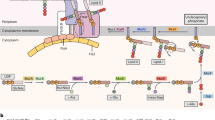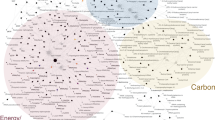Abstract
The 1,860,725-base-pair genome of Thermotoga maritima MSB8 contains 1,877 predicted coding regions, 1,014 (54%) of which have functional assignments and 863 (46%) of which are of unknown function. Genome analysis reveals numerous pathways involved in degradation of sugars and plant polysaccharides, and 108 genes that have orthologues only in the genomes of other thermophilic Eubacteria and Archaea. Of the Eubacteria sequenced to date, T.maritima has the highest percentage (24%) of genes that are most similar to archaeal genes. Eighty-one archaeal-like genes are clustered in 15 regions of the T. maritima genome that range in size from 4 to 20 kilobases. Conservation of gene order between T. maritima and Archaea in many of the clustered regions suggests that lateral gene transfer may have occurred between thermophilic Eubacteria and Archaea.
This is a preview of subscription content, access via your institution
Access options
Subscribe to this journal
Receive 51 print issues and online access
$199.00 per year
only $3.90 per issue
Buy this article
- Purchase on SpringerLink
- Instant access to full article PDF
Prices may be subject to local taxes which are calculated during checkout





Similar content being viewed by others
References
Huber, R.et al. Thermotoga maritima sp. nov. represents a new genus of unique extremely thermophilic eubacteria growing up to 90 °C. Arch. Microbiol. 144, 324–333 ( 1986).
Huber, R. & Stetter, K. O. in The Prokaryotes (eds Balows, A. et al.) 3809–3815 (Springer, Berlin, Heidelberg, New York, (1992).
Achenbach-Richter, L., Gupta, R., Stetter, K. O. & Woese, C. R. Were the original eubacteria thermophiles? Syst. Appl. Microbiol. 9, 34–39 (1987 ).
Fleischmann, R. D.et al. Whole-genome random sequence of Haemophilus influenzae Rd. Science 269, 496– 512 (1995).
Klenk, H.-P.et al. The complete genome sequence of the hyperthermophilic, sulphate-reducing archaeon Archaeoglobus fulgidus. Nature 390, 364–370 (1997).
Lobry, J. R. Asymmetric substitution patterns in the two DNA strands of bacteria. Mol. Biol. Evol. 13, 660–665 (1996).
Salzberg, S., Salzberg, A., Kerlavage, A. & Tomb, J.-F. Skewed oligomers and origins of replication. Gene 217 , 57–67 (1998).
Bult, C. J.et al. Complete genome sequence of the methanogenic archaeon Methanococcus jannaschii. Science 273, 1058– 1073 (1996).
Salzberg, S. L., Delcher, A. L., Kasif, S. & White, O. Microbial gene identification using interpolated Markov models. Nucleic Acids Res. 15, 544–548 (1998).
Riley, M. Functions of gene products of Escherichia coli. Microbiol. Rev. 57, 862–952 ( 1993).
Deckert, G.et al. The complete genome of the hyperthermophilic bacterium Aquifex aeolicus. Nature 392, 353– 358 (1998).
Saier, M. H. J Computer-aided analyses of transport protein sequences: gleaning evidence concerning function, structure, biogenesis, and evolution. Microbiol. Rev. 58, 71–93 ( 1994).
Kawarabayasi, Y.et al . Complete sequence and gene organization of the genome of a hyperthermophilic archaebacterium, Pyrococcus horikoshii OT3. DNA Res. 5, 55–76 ( 1998).
Boos, W. & Lucht, J. M. in Escherichia coli and Salmonella Cellular and Molecular Biology (eds Neidhardt, F. C. et al.) 1175–1209 (ASM, Washington, (1996).
Bronnenmeier, K., Kern, A., Liebl, W. & Staudenbauer, W. L. Purification of Thermotoga maritima enzymes for the degradation of cellulosic materials. Appl. Environ. Microbiol. 61, 1399– 1407 (1995).
Felix, C. R. & Ljungdahl, L. O. The cellulosome; the exocellular organelle of Clostridium. Annu. Rev. Microbiol. 47, 791–819 (1993).
Vargas, M., Kashefi, K., Blunt-Harris, E. L. & Lovley, D. R. Microbiological evidence for Fe(III) reduction on early Earth. Nature 395, 65–67 ( 1998).
Janssen, P. H. & Morgan, H. W. Heterotrophic sulfur reduction by Thermotoga sp. strain FjSS3.B1. FEMS Microbiol. Lett. 75, 213–217 (1992).
Gluch, M. F., Typke, D. & Baumeister, W. Motility and thermotactic responses of Thermotoga maritima. J. Bacteriol. 177, 5473– 5479 (1995).
Lee, P. J. & Stock, A. M. Characterization of the genes and proteins of a two-component system from the hyperthermophilic bacterium Thermotoga maritima. J. Bacteriol. 178, 5579–5585 (1996).
Macnab, R. M. in Escherichia coli and Salmonella Cellular and Molecular Biology (eds Neidhardt, F. C. et al.) 123–145 (ASM, Washington, (1996).
Hueck, C. J. Type III protein secretion systems in bacterial pathogens of animals and plants. Microbiol. Mol. Biol. Rev. 62, 379– 433 (1998).
Dubnau, D. Binding and transport of transforming DNA by Bacillus subtilis : the role of type IV pilin-like proteins—a review. Gene 11, 191–198 (1997).
Gruber, T. M. & Bryant, D. A. Molecular systematic studies of eubacteria, using sigma70-type sigma factors of group 1 and group 2. J. Bacteriol. 179, 1734–1747 (1997).
Zhang, J., Hardham, J., Barbour, A. & Norris, S. Antigenic variation in Lyme disease Borreliae by promiscuous recombination of VMP-like sequence cassettes. Cell 89, 275– 285 (1997).
Tomb, J.-F.et al. The complete genome sequence of the gastric pathogen Helicobacter pylori. Science 388, 539– 547 (1997).
Curnow, A. W., Ibba, M. & Soll, D. tRNA-dependent asparagine formation. Nature 382, 589–590 (1996).
Brown, J. R. & Doolittle, W. F. Archaea and the prokaryote-to-eukaryote transition. Microbiol. Mol. Biol. Rev. 61, 456–502 (1997).
Eisen, J. A. The RecA protein as a model molecule for molecular systematic studies of bacteria: comparison of trees of RecAs and 16S rRNAs from the same species. J. Mol. Evol. 41, 1105–1123 (1995).
Smith, D. R.et al. Complete genome sequence of Methanobacterium thermoautotrophicum ΔH: Functional analysis and comparative genomics. J. Bacteriol. 179, 7135–7155 (1997).
Kunst, F.et al. The complete genome sequence of the gram-positive bacterium Bacillus subtilis. Nature 390, 249– 256 (1997).
Fraser, C. M.et al. Genomic sequence of a Lyme disease spirochete, Borrelia burgdorferi . Nature 390, 580–586 (1997).
Blattner, F. R.et al . The complete genome sequence of Escherichia coli K-12. Science 277, 1453– 1462 (1997).
Cole, S. T.et al. Deciphering the biology of Mycobacterium tuberculosis from the complete genome sequence. Nature 11, 537–544 (1998).
Fraser, C. M.et al. The minimal gene complement of Mycoplasma genitalium. Science 270, 397–403 (1995).
Himmelreich, R.et al . Complete sequence analysis of the genome of the bacterium Mycoplasma pneumoniae. Nucleic Acids Res. 24, 4420–4449 (1996).
Kaneko, T.et al. Sequence analysis of the genome of the unicellular cyanobacterium Synechocystis sp. strain PCC6803. II. Sequence determination of the entire genome and assignment of potential protein-coding regions. DNA Res. (suppl.) 3, 185–209 (1996).
Fraser, C. M.et al. Complete genome sequence of Treponema pallidum, the syphilis spirochete. Science 281, 375– 388 (1998).
Goffeau, A.et al. Life with 6000 genes. Science 274, 563–567 (1996).
Huang, Y.-P. & Ito, J. The hyperthermophilic bacterium Thermotoga maritima has two different classes of family C DNA polymerases: evolutionary implications. Nucleic Acids Res. 26, 5300–5309 (1998).
Lawrence, J. G. & Ochman, H. Amelioration of bacterial genomes: rates of change and exchange. J. Mol. Evol. 44, 383–397 ( 1997).
Sutton, G. G., White, O., Adams, M. D. & Kerlavage, A. R. TIGR Assembler: A new tool for assembling large shotgun sequencing projects. Genome Seq. Technol. 1, 9–19 ( 1995).
Altschul, S. F., Gish, W., Miller, W., Myers, E. W. & Lipman, D. J. Basic local alignment search tool. J. Mol. Biol. 215, 403–410 (1990).
Saitou, N. & Nei, M. The neighbor-joining method: A new method for reconstructing phylogenetic trees. Mol. Biol. Evol. 4, 406–425 (1987).
Claros, M. G. & von Heijne, G. TopPred II: an improved software for membrane protein structure predictions. Comput. Appl. Biosci. 10, 685–686 ( 1994).
Acknowledgements
This work was supported by the US Department of Energy, Office of Biological and Environmental Research. We thank M. Heaney, J. Scott, D. Maas and B. Vincent for software and database support; R. Roberts, F. Kunst, and M. Simon for useful discussions; and R. Huber for providing T.maritima MSB8 cells.
Author information
Authors and Affiliations
Corresponding author
Rights and permissions
About this article
Cite this article
Nelson, K., Clayton, R., Gill, S. et al. Evidence for lateral gene transfer between Archaea and Bacteria from genome sequence of Thermotoga maritima. Nature 399, 323–329 (1999). https://doi.org/10.1038/20601
Received:
Accepted:
Issue Date:
DOI: https://doi.org/10.1038/20601
This article is cited by
-
Harnessing transaminases to construct azacyclic non-canonical amino acids
Nature Synthesis (2024)
-
Identification of a deep-branching thermophilic clade sheds light on early bacterial evolution
Nature Communications (2023)
-
Genomic attributes of thermophilic and hyperthermophilic bacteria and archaea
World Journal of Microbiology and Biotechnology (2022)
-
The Polar Fox Lagoon in Siberia harbours a community of Bathyarchaeota possessing the potential for peptide fermentation and acetogenesis
Antonie van Leeuwenhoek (2022)



